Castle Falkenstein by Wapole Languray
Welcome to Castle Falkenstein!
Original SA post
It was 1994, and White Wolf was King. Vampire: The Masquerade had came out three years earlier in 1991 and tabletop gaming was never the same. This was the age of experimental systems, gobs upon gobs of metaplot, and things were getting weird and dark.
So, in 1994, Mike Pondsmith made a game. One has to wonder, what did people expect? He was still a semi-famous guy, he made Cyberpunk: 2020 after all, the first and some would argue best of its kind. His other games were anime-mech themed Mekton and silly sci-fi adventure Teens from Outer Space! So, what would a gamer in say, 1993 think a new Mike Pondsmith game would be? Maybe a new edition of Cyberpunk: 2020? Maybe something that’s pretty much the same. Whatever it is, you could be safe to assume it would be sci-fi. Probably dark and grim and gritty, and very very “serious”. The sci-fi answer to White Wolf in short, right?
Right?
Wrong.
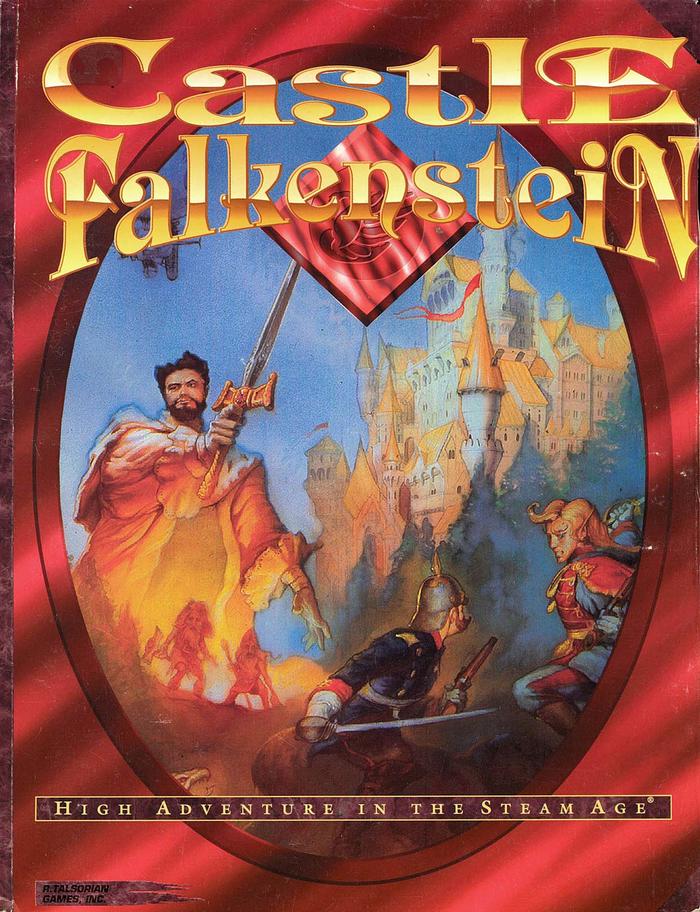
I discovered this game via this thread in fact. Somewhere around page 13 or so, somebody mentioned this game, and I just thought the name was interesting. I tracked down a copy, picked it up, started reading, and now I’m here to tell everyone else about it.
Welcome to Castle Falkenstein!
Upon reaching the first page of the book, you realize three things:
-
One
: That this book is fucking beautiful. Ignoring the wonderful painted artwork throughout, which I will be posting during the read through, the pages themselves are gorgeous. Just look at this!
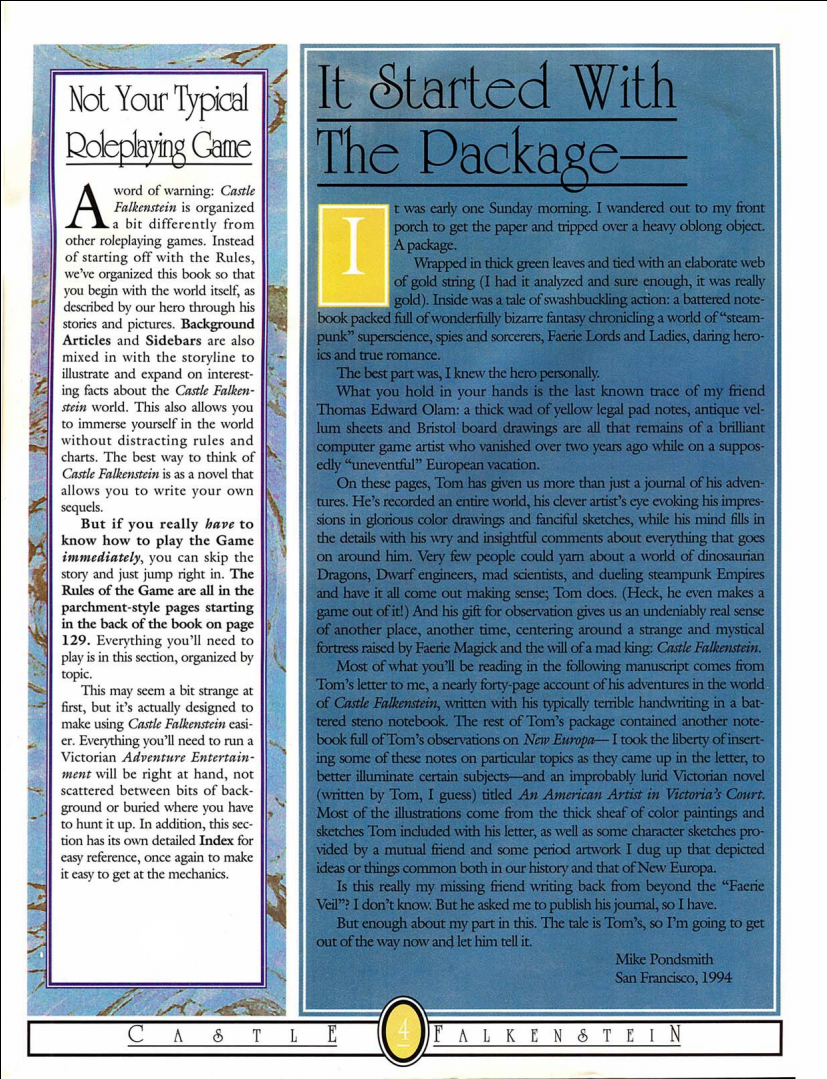
-
Two
: They actually did something that more RPG’s need to do, and completely separated the Rules and Setting portions of the book, so it is much easier to just flip around and find rules you need without the bother of them being scattered around in between chunks of lore.
-
Three
: The book is purported to be the writings of one Tom Olam, appearently based on a friend of Mike Pondsmith's who was Ultima-style sucked into the magical world of Castle Falkenstein, and sent back several notebooks to the real world Mike Pondsmith who was his friend and published them all for us to read. The normal assumption is that this is a fucking terrible idea and would be near unreadable. This is fair, and I had my fears as well! But, hey, turns out it works pretty well. Tom Olam, the narrator, is pretty inoffensive, and on the whole it comes across more like a combination of Ultima and
Dinotopia
. In fact, the whole lore section reminds me of the first
Dinotopia
book, and I can’t think of any higher praise.
So join me at Castle Falkenstein next time, for Spellnapped! the actual beginning of the book!
Spellnapped!: In Which the Principle Players are Introduced, the Setting Is Established, and the Adventure Begins.
Original SA post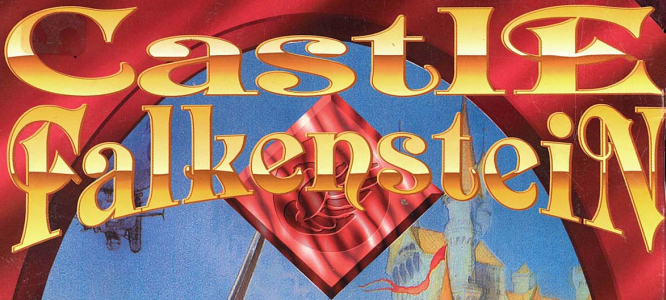
Spellnapped!: In Which the Principle Players are Introduced, the Setting Is Established, and the Adventure Begins.
As previously mentioned, the book is written as the journals of Tom Olam, a game designer for Hypertech Inc. The story begins with Tom on vacation in Europe, visiting scenic Neuschwanstein (New Swan Rock) castle in Bavaria. If you’ve never seen it, here’s a picture:
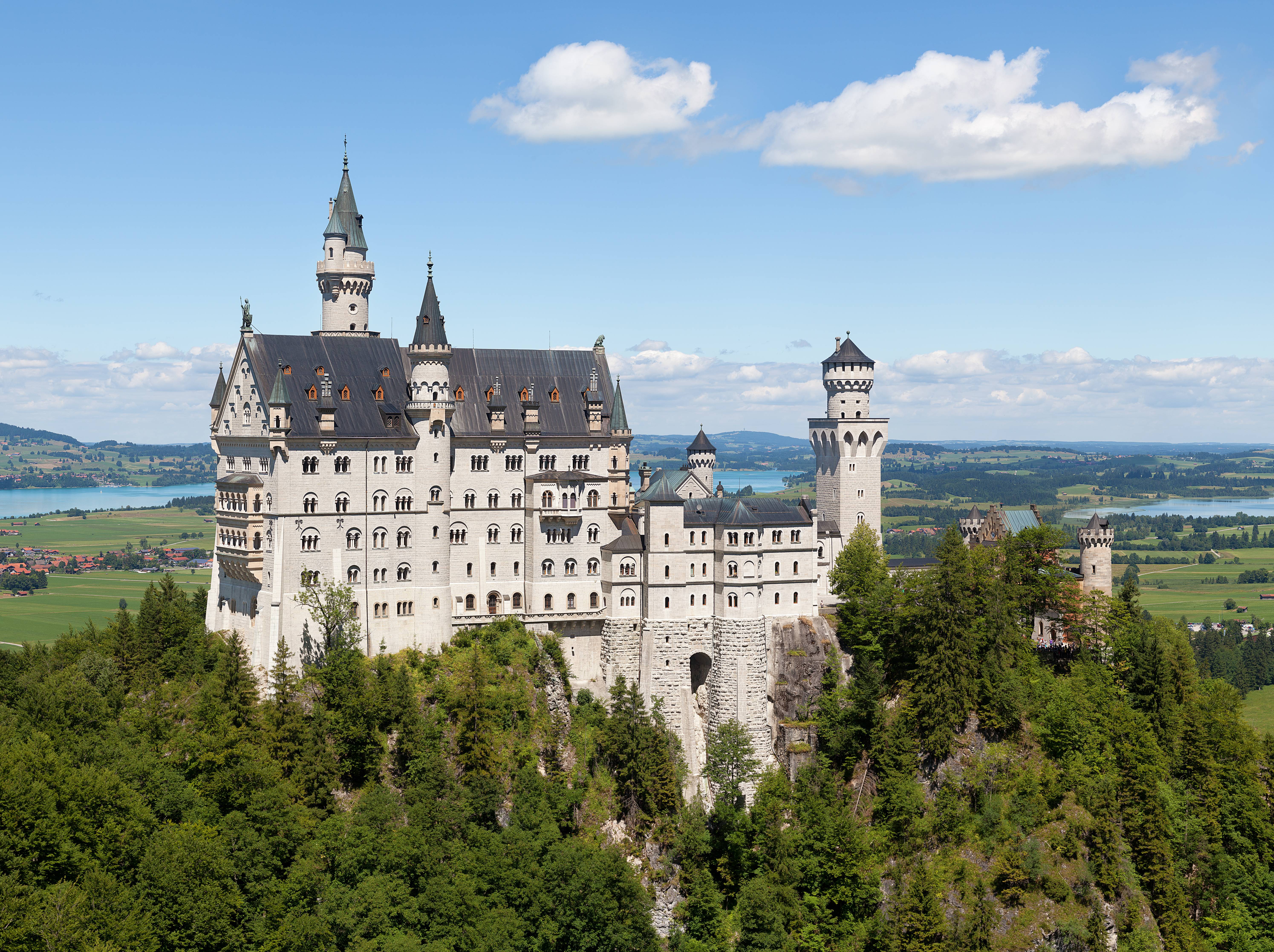
If you couldn’t tell, this is the basis for most fairy-tale castles you’ve seen in Disney films, in particular Cinderella’s Castle, which is the centerpiece of Disney’s Magic Kingdom and features prominently in the Disney logo.
Neuschwanstein was built as a sort of dream-home for the eccentric and reclusive King Ludwig II of Bavaria, before he mysteriously died the day after being declared insane, and in no way was assassinated for being a crazy recluse that payed for the castle by plunging Bavaria into debt. While in Neuschwanstein, Tom gets distracted sketching the architecture of the castle and loses his tour-group. He notices but isn’t particularly bothered, up until a magic hole made of rainbows and fire sucks him into another dimension.
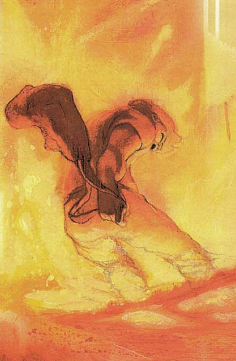
Then we get a rough overview of the setting that I’m skipping, as it’ll all be filled in later. The only important thing it tells you is this: The world of Castle Falkenstein is a mixed up version of Europe, called New Europa in this world, circa the mid 1800s, just with crazy steampunk technology, magick, faeries, and other such things running around.
The book often does this, inserting what is essentially setting info in between the narrative sections, so forgive me if it seems like I’m jumping between topics. The point of this is to simultaneously show you the game’s world, as well as tell a story that is in essence the exact sort of adventure you’re planned to play in the game. Unlike most other books with a focus on what are essentially GMPCs doing stuff, it is made obvious that they aren’t special superpeople doing things the players will never get to do (ala Deadlands, many White Wolf books, older Forgotten Realms), but are typical examples of PCs and the sorts of adventures you SHOULD be running!
But, we must return to the story for a moment. Upon waking he discovers who spellnapped him: Grey Morrolan, Wizard of the Illuminated Brotherhood of Bayern (Yes, the Illuminati) and Lord Auberon Valerix, High King of the Faerie and Lord of the Seelie Court.
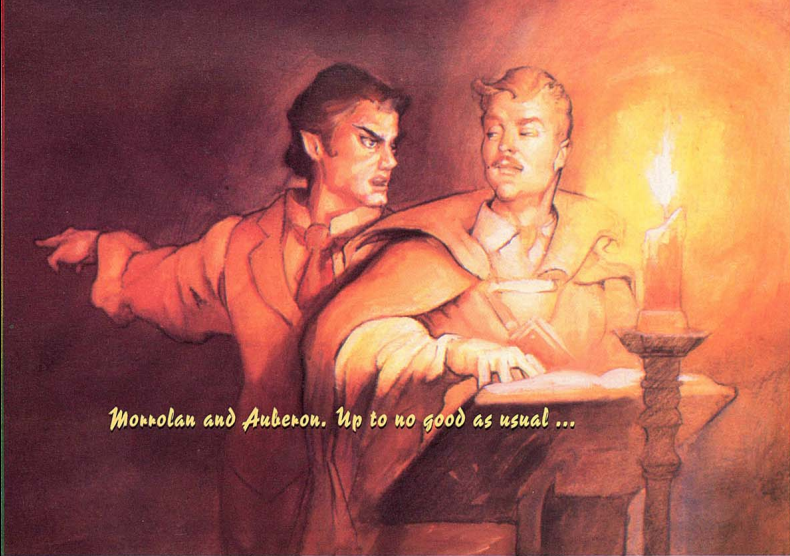
See, they were attempting to get, well, something to help them (Why they need help will be explained later. The book is only vaguely chronological), but instead of being specific they just used a spell that pulled whatever would be most useful to them from another dimension, and for some reason they get a game developer from 1994 Earth. They are rather less than impressed.
Back to Lore now! So to contextualize the other characters we are to meet, the book feels that it must first design the setting we will be meeting them in: The Kingdom of Bayern (An archaic name for Bavaria), and in particular the eponymous
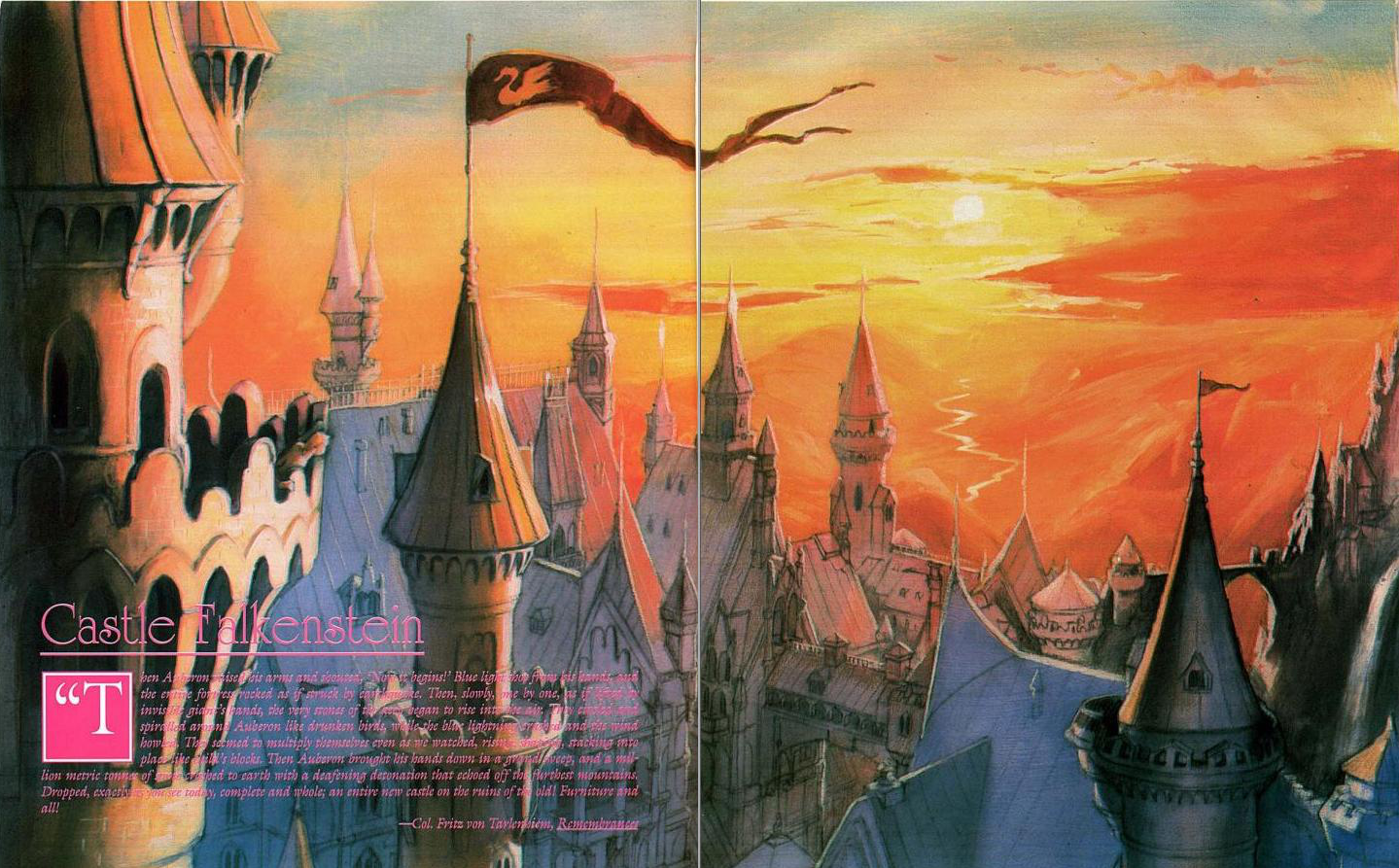
It’s interesting to note that Falkenstein (Falcon Stone), at least the Castle the game is named after, does not exist in our world. At least, not outside of paintings and designs. It was planned to be a sort of Neuschwanstein II, if Ludwig II hadn’t gotten mysteriously not-alive.So, already you got the weirdness of a castle that only existed in our world conceptually. Then you add in the fact that it wasn’t built by men, but faeries. Or faerie. See, the castle was created by Lord Auberon pretty much from scratch, built not by hands but by Magick, and as such the whole thing is all sortsa wacky. The castle is so massive nobody has so far actually mapped it out, rooms appear and disappear, constantly changing, and the thing even passes through alien dimensions. Go wandering too deep into the castle and you may never return, and strangers speaking strange tongues and wearing strange clothes have just appeared, wandering in from distant rooms confused and lost.
Then there’s the massive cave system that stretches miles down into the Earth that is so saturated with magick it’s basically a death sentence to explore it. They don’t say much, except that it is likely where Faeries first came to New Europa and it may in fact be the most powerfully magickal place in the world.
As you might imagine, it’s rarely used by the Bayern government, and acts more in a symbolic function, though if an event of state is big and important enough they hold it here.
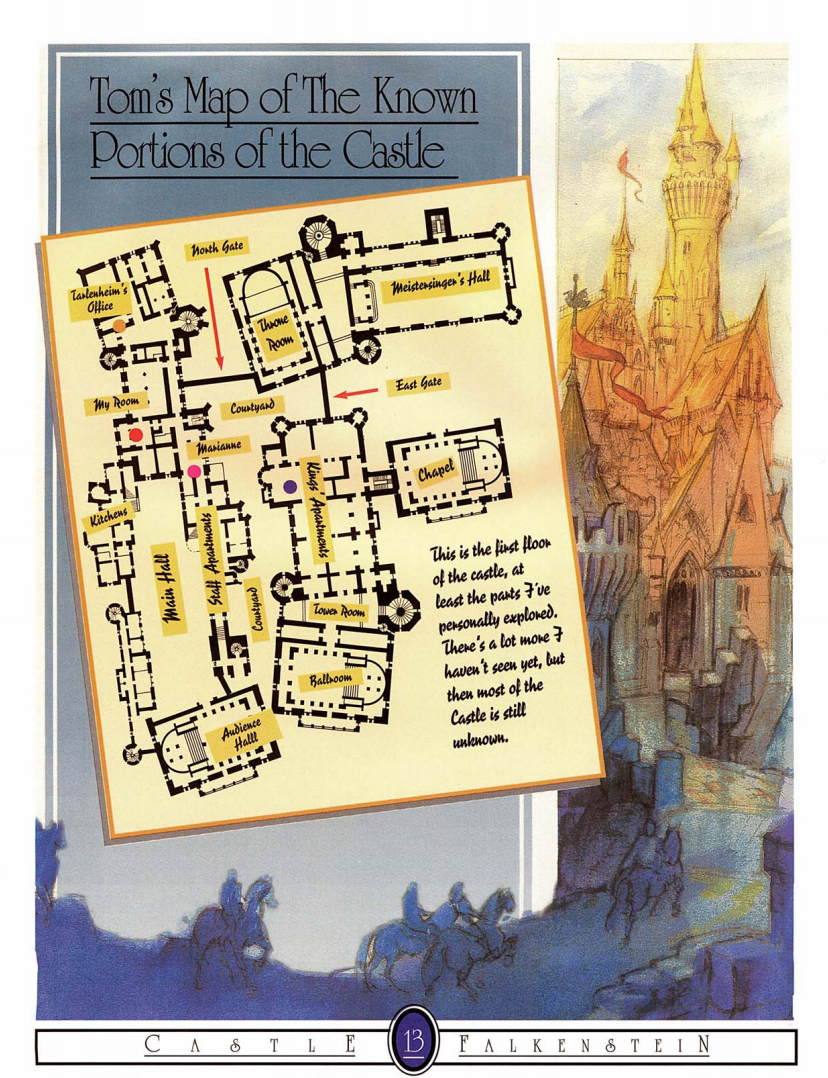
Now we come to lovely scenic Bayern . Or Bavaria, if you speak English. This is pre-Germanic unification, so Bayern is an independent nation, and in fact is the second largest Germanic state next to Prussia. The politics of Bayern will be explored later, as of now what is important is the feel of the country. Bayern is a proto-typical Fairy-Tale kingdom, mostly filled with rolling hills and glades full of peaceful rustic villages, and the more playful and friendly sorts of Fae abound. So, lots of little wooden houses with colorful flower gardens, cheerful red faced peasant-folk who love guests and are hospitable to a fault to anyone except vampires (or worse, Anarchists!), and inns where you can always find an affordable bed the size of a small house and an ornate stein full of the Best Beer in the World (According to the Bayernese).
The cities are well developed, if not nearly as cosmopolitan and impressive as Paris or London. Construction is of brick and cobble, with Old Munchen (Munich) being the largest and most populous city, the center of both government and culture. As for non-human residents, the wilds of Bayern are teeming with the Fae, in particular the nicer sorts. Brownies help with the housework, Goblins play pranks on the village people, Pixies dance among the fields and flowers, etc. etc. Of note is the existence of the Weisse Damen, or White Lady, a type of forest Faerie unique to Bayern who live in the deep woods. They act as protectors, particularly of children and guide them out of the woods back home if they become lost at night.
In the south Bayern is bordered by the mighty Alps, home to quite a number of non-Humans who you may see in Bayern. The high peaks of the mountains are the traditional homes of Dragons, and are also haunted by Trolls, Giants, and other nasty Fae who take refuge in the high passes to ambush or extort travelers. Inside the mountains are many Dwarf cities, making the mountains the heart of New Europan engineering (You’ll learn about Dwarfs later).
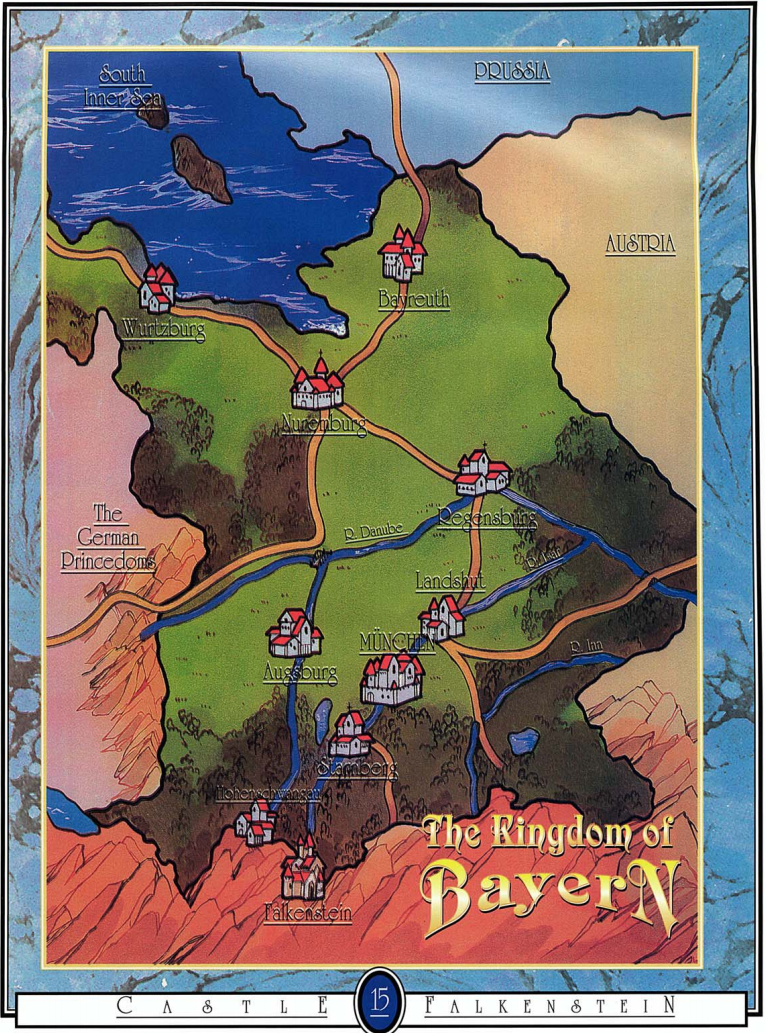
Oh hey, if you’re sharp eyed you may have noticed something weird about that map. If you didn’t, either you didn’t actually look at the map, or you don’t know where Bavaria is in the real world. Just, look close. See, up there? In the top left? Now do you notice it?
So, what the hell is an ocean doing in central Europe?
The Inner sea stretches from just south of Amsterdam all the way to just north of Nuremberg. It’s about “half again the size of Lake Superior in the United States” and is several thousand feet deep at at its widest about three hundred miles across. So, how did it get there? According to local lore, way back in prehistory, a Faerie lord climbed up to the top of the Alps and just ripped a giant hole in central New Europa. So, now Bavaria has a northern coast and Wurzburg is a port-town.
Next Time: Spellnapped! Part Zwei; We Meet the Rest of our Players, and Learn about Ladies, Dwarves, Kings, Faeries, and Smart Career Choices for The Young Gentle(wo)man
Spellnapped! Part Zwei; We Meet the Rest of our Players, and Learn about Ladies, Dwarfs, Kings, Faeries, and Smart Career Choices for The Young Gentle(wo)man
Original SA post Spellnapped! Part Zwei; We Meet the Rest of our Players, and Learn about Ladies, Dwarfs, Kings, Faeries, and Smart Career Choices for The Young Gentle(wo)manMarianne
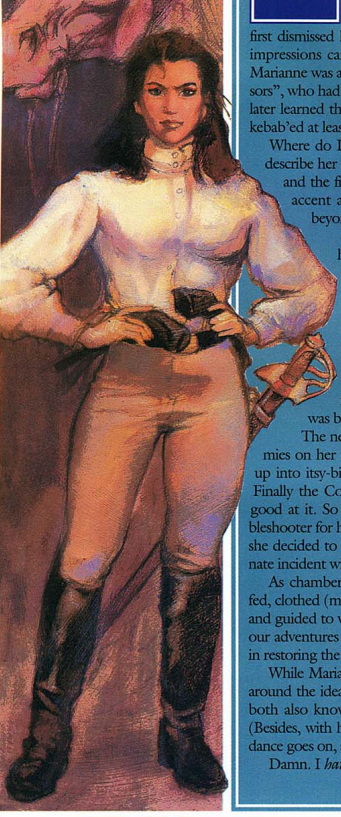
Countess Marianne Theresa Desiree is a flower of French nobility. She is beautiful to a fault, has an adorable French accent, a love for elegant frilly dresses, and has killed at least thirty men in duels across New Europa. Forced to flee France after a Parisian noble’s son tried to rape her and she responded by gutting the little shit, she has been to every corner of New Europa and places beyond. She is assigned to be Tom’s bodyguard and guide, and eventually becomes a proper love-interest, in an on-again off-again way. Hard to commit when most of your boyfriends are dead. Because you killed them.
Lady, Adventuress, Demimondaine
Now we must discuss Women in the world of Castle Falkenstein. Which is a bit of a sticking point, yes? I mean, the fact is the Real Victorian Era was pretty damn shitty about women’s rights. So, what about Castle Falkenstein? Pretty much Feminism has happened, and is winning. Women are, in almost every way, equal to men. They can own property, run businesses, and participate in any career they please. The reason for this is twofold: One, is that women are much more likely to be born with a talent for Magick, and they are often stronger than their male counterparts; and Two, act misogynistic to a Fae woman and you’ll be wondering why your leg is bending that way.
This does not mean that women are exactly like men though. There are parts of New Europan society where women excel far beyond their male counterparts. The most visible is that all the greatest celebrities are women. Oh sure there are famous male opera singers and actors, but it is the women who are the real stars of the show. Ladies also are dubbed the leaders of New Europan Society, with a capital S. They say what is in, what is out, and who is who. If that sounds rather insulting, understand this: Everything in New Europa is done at balls, soirees, salons and dinner parties. Every connection you make, every friend and ally you find, you most likely will meet at a Society Event. Get on the wrong Ladies side, and she’ll make sure you never talk to anyone more important than the local bartender again.
And of course, you cannot forget the Demimondaine. In our world, a Demimondaine was a sort of proto-Feminist, a precursor to the Flapper of the early 1900s. In Castle Falkenstein though, they are a mix of Diva, Celebrity and Courtesan. Demimondaine’s are the most fashionable, most desirable, and most popular women on the continent. They set all the trends, are lavished upon by men of every type and description, and fill the newspapers with their exploits and scandals. Mind, mess with a Demimondaine and she will gladly bury you. A good demimondaine has connections everywhere, with men, and sometimes women, at all levels of power. They can easily grease the gears of the world, or throw you into the teeth.
Colonel Tarlenheim
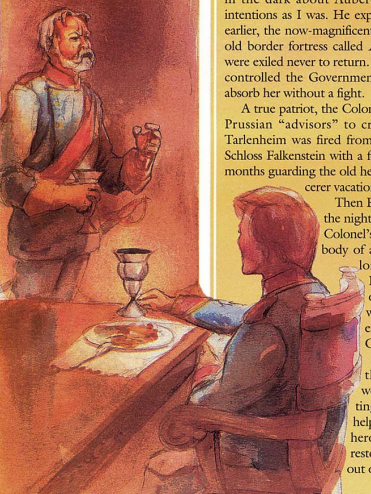
Colonel Rudolph von Tarlenheim is the Garrison Commander of Castle Falkenstein, and the definitive Old Soldier. Formerly both Commander in Chief of the Bayernese Guard and the Head of His Majesty’s Secret Service, until Ludwig II “died” in a yachting accident, and was replaced by an as yet unnamed Regent who was running Bayern into the ground. Tarlenheim was rather displeased with this, and objected to the Regent’s actions, in particular the allowance of Prussian “advisors” into Bayern. As a reward Tarlenheim was fired and given command of Alt Schloss Fakenstein (Old Castle Falcon Rock) a ruined fortress used as a border post where disgraced soldiers were stationed to keep them out of the way.
He stayed there for several years guarding a rotting pile of rocks and watching Bayern go to pot, his only friend being Morrolan the Sorcerer. Then one day Auberon showed up with King Ludwig himself, magickally built Falkenstein in a single night on the ruins of the old castle, and made Tarlenheim the new garrison commander of the new Falkenstein.
Soldier, Sailor, Tinkerer...Wizard?
This is a short section on the sort of careers one might pursue in New Europa, and works to give your players an idea of what sort of people you can play or meet in the setting of Castle Falkenstein. I’m also skipping it, as it’s literally just a list of jobs you can have, and honestly this is better explained everywhere else in the book, so I’m not going to be repeating myself over and over again.
Rhyme: Dwarf Mad Scientist
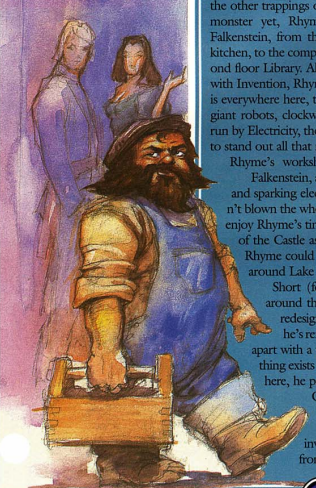
Rhyme is the resident handyman and castle Mad Scientist. As a day job he keeps the castle in “repair”, which is rather difficult as it is highly magickal. When the foundation is non-euclidian, a handyman has his work cut out for him! But, Rhyme’s real passion is SCIENCE! He has an entire basement level dedicated to a massive lab and has invented such wonders as a turbine powered roasting spit, a mechanical swan-boat, and a mirror based lighting system for the windowless second floor library. He also has no sense of personal property, and sees everything in Falkenstein as free for him to fix, improve, or overhaul as he sees fit.
About Dwarfs
Dwarfs in Castle Falkenstein are, like most mythical things, much more tied to folklore than Tolkienian tradition. They do not wear furs or chainmail or leather, in fact they like a nice pair of workman’s coveralls when they’re on the job and a nice three-piece suit when they’re not. If a dwarf is carrying a hammer it’s to flatten nails or detail metal, and axes are right out for anything that isn’t chopping wood. Dwarfs prefer sabers and pistols, same as anyone else, though an angry dwarf with a sizable wrench isn’t to be underestimated. They also aren’t that short, ranging between 4 foot and 5’ 5’’. They do look shorter than they are mainly because all dwarves are built like brick houses, being almost as wide as they are tall. Heck, they don’t even all have beards! Some rather enjoy goatees and moustaches as an alternative to the traditional big bushy beards.
Dwarfs do live underground, though they aren’t miners. They leave that to Kobolds and other mine-spirits, for Dwarfs are craftsmen. They make things, and not ordinary things either. Every object made by a dwarf is a unique work of art and ingenuity, and you can tell a dwarf, or dwarfhold, just by looking at a devices styling and build.
Oh, and one last little Tolkeinism to dispel: There are no female Dwarfs. Why? Well, Dwarfs are technically (It’s explained later) Faeries. As such, when a Dwarf wants to start a family he marries a nice Seelie Fae girl of some sort such as a Dryad or Sidhe. The boys are always Dwarfs and the girls are whatever sort of Fae the mother is. Dwarf/Fae couples rarely stay together though, with the Dwarf raising the Sons and the Fae mother raising the daughters, with the whole family visiting if they are close and getting together in big family reunions several times a year.
Now, we must cover a few things that are uniquely Falkenstein. Firstly, Dwarfs are only technically Faeries. They lack both the traditional powers of the Fae, as well as their weaknesses. Why? It’ll be explained later, this is just a quick intro so that people don’t wonder what the heck is up with those Dwarfs as they read the book. They also only live, at least in any great numbers, in continental New Europa, particularly the Alps and Scandinavia.
One very odd thing about Dwarfs are their feet. Dwarf feet look birdlike, similar to a duck or chicken, and they are chronically embarrassed about them. A Dwarf is never to be seen without his shoes, and making fun of a Dwarfs feet is the gravest of insults. I have NO idea where this idea comes from, I’m assuming some obscure bit of folk-mythology that isn’t on the internet, but if someone can tell me where this idea is from I’d appreciate it.
The Mad King: Ludwig the Second
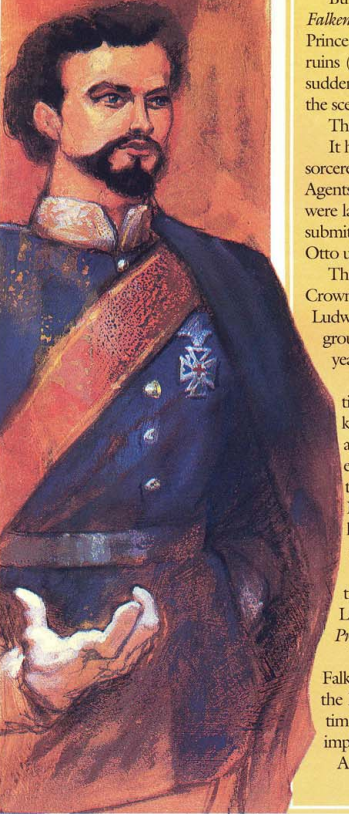
In New Europa, Prince Ludwig, heir to the throne of Bayern myseriously vanished in a shipwreck in the Aegean Sea, never to be found. This led to his insane brother Otto (He thinks he’s a dog) to take the throne, under the Regency of the Chancellor Count Hohenloe, who proceeded to basically sell Bayern out to the Prussians.
Then one day years later, Auberon shows up with Ludwig over one shoulder and a plan to put him back on the throne! Now, this works quite well, though the book never properly tells you how they did it because honestly it’s not that important for players! It’s enough to say there is much derring-do and clever schemes and such that led to Mad King Otto getting the boot and Ludwig getting the crown.
What does matter is the fact that both Morrolan and Tom Olam don’t think that he’s the real Ludwig. Or, at least not the Ludwig that went missing all those years ago. See, Auberon claims that he was kidnapped by the Unseelie Court (More on them in a bit), and was hidden in the Faerie Veil (More on that later as well, but “Faerie Land” is good enough for now) but this doesn't add up. The Ludwig Auberon brought back is about 5 years older than he should be, acts far more… stable than Ludwig should act, and in particular knows thing she shouldn't. He knows what telephone’s are (Not yet invented), talks of Neuschwanstein (Which he hasn't built), and mentioned works of Richard Wagner that aren't yet written! (The real Ludwig II was a huge supporter and patron of Richard Wagner)
So, Tom and Morrolan are pretty sure that the “real” Ludwig is long dead, and this is a Ludwig from another world. Which is considered to be rather disconcerting. Not because of Ludwig, who is a fine and upstanding king in every aspect, but because Auberon is involved. And the Fae make everything complicated, no matter how well meaning they are.
Cousin Sisi: Empress Elizabeth of Austria
This is a short bit, but I like it. There’s mention of Elizabeth being Ludwig’s best friend and closest relation, as well as a bonified Adventuress. Appearently she has
quote:
... tied herself to the mast of her yacht during a storm, gone on expeditions to India, and studied eastern mysticism-strange behavior indeed for an Empress, but not all that unusual in this extended family of dreamer-philosopher kings.
The Iron Chancellor: Otto von Bismarck
In the real world Otto von Bismarck was a Prussian statesman who unified the various Germanic kingdoms of Europe into the German Empire, stabilized Europe politically, and was generally an uncompromising but not evil man. Heck, he’s the one who invented the idea of a welfare state! Mind, this was to make sure the poor didn’t overthrow the government in a communist revolution, but still. What I’m getting at is that he was not a proto-Hitler, but was a fairly complex man who did things both good and bad.
Now, Castle Falkenstein Otto von Bismarck is basically the same guy, if he was also a Bond villain. Otto von Bismarck is Falkenstein’s general Big Bad, the main top dog villain that, alongside say Professor Moriarty and the Steam Lords, will be at the root of many of the Evil Doings the players will foil. Well, sorta. See, to really tell you about Bismarck, I have to tell you about the real Big Bad. The True Villain. The guy who may just be behind pretty much every villainous plot in New Europa, and if he isn’t he wants to be.
The Adversary: Lord of the Unseelie Court
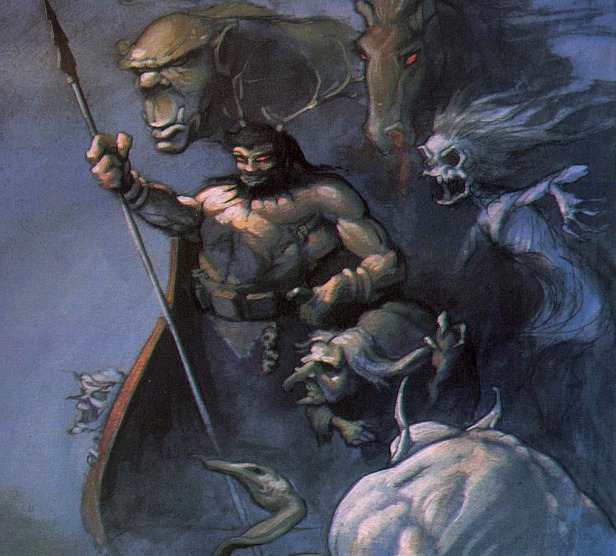
The Fairie Host is made up of two general factions: The Seelie and Unseelie Courts. The Seelie court, ruled by Lord Auberon, are generally fond of humanity and wish to live alongside us in relative harmony. The Unseelie, led by a being only known as The Adversary, do not. They want nothing more than to sweep across the world, killing or enslaving every human they find. And, if it wasn't for the Compact, they’d do it too. The Compact is a peace-treaty of sorts, which Auberon tricked the Adversary into signing. The Compact makes war between Faerie and Humans… not illegal exactly, but impossible. Auberon cannot march forth to slaughter the Unseelie, but the Unseelie cannot do the same, or march against Humanity, on pain of death. Not as a legal consequence, but a literal one: For a Faerie to break a promise is instant death.
This means the Adversary instead seeks to make Humanity enslave and destroy itself, using a series of puppet rulers to do his conquering for him, and his current favorite is The Iron Chancellor himself.
Otto von Bismarck: Zwei Harder
Okay, so, now that you know about the Adversary, I can finish talking about Bismarck. Bismarck is, as I said, basically the same fellow he was historically. Big, blustery, very little temper, and the ability to run roughshod over any political opponent by sheer force of will. Add to that a lifetime of experience in statesmanship, a keen military mind, a massive spy network, and the aid of an extra-dimensional Demigod and his army of monsters, Bismarck is rightly feared by every power in Europe, as he’s very unlikely to settle for just conquering the German kingdoms.
There are two notable things about Bismarck, and by extension Prussia, that stand out. Firstly, he has Tanks. Well, they call them Landwehr Fortresses, but they’re basically big clunky steam-tanks, courtesy of the Adversary. Second, he’s literally a Bond villain, complete with a weird disfigurement, in the form of a clockwork left arm loaded with gadgets and weapons.
Woof, that’s a lot of text. This update took ages to write up because the book isn't in any sort of… chronological order, so I skipped around a bit to make it more readable in post-form. Fortunately, the next few should go much quicker. So be back next time for
To Rule the World! The Nations of Castle Falkenstein
To Rule the World! The Nations of Castle Falkenstein
Original SA post
Speaking of, GUESS WHAT TIME IT IS!
To Rule the World! The Nations of Castle Falkenstein
It’s time to learn about the nations of this strange new world we find ourselves in! History nerds are welcome to geek out now.
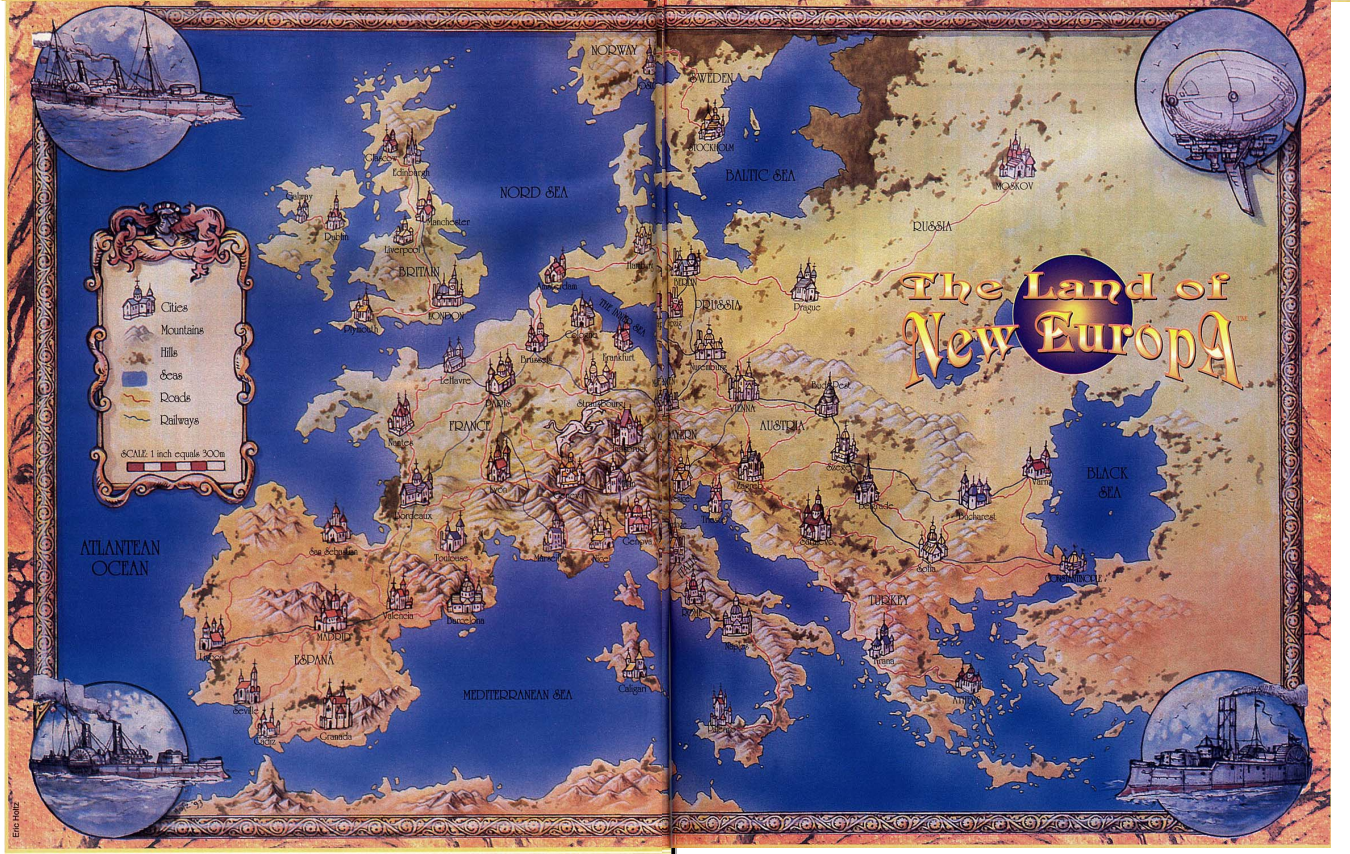
The Kingdom of Bayern (Bavaria)

Ruled by the extensive Wittlesbach family, Bayern is a constitutional monarchy ruled currently by King Ludwig II. It is a peaceful nation which holds to enlightened and cosmopolitan ideals. It is known for both it’s advanced technology and magickal arts.
Geographically Bayern is mostly gently rolling hills and heavy forests. Your typical village is made up of a collection of wooden cottages, small churches, lots of flowers, and a central market square with at least one Inn and beer-garden.
The most important part of the country is the capital of Munchen (Munich). Built mostly in Neo-Grecian style, and is known for its high culture and academia. Notable locations are the Alte Pinothek, one of the largest art galleries on the continent, the Residenz, home of King Ludwig and the Royal Palace, the Englishergarten, a massive Victorian park, and the University capital of Germanic learning.
The Austrian-Hungarian Empire

Formerly a powerhouse of New Europa, the Austrian-Hungarian Empire is now showing its age, though it still serves as an international center and is not to be dismissed. The Empire is an absolute monarchy ruled by the kindly Emperor Franz Joseph, and held together by one of the largest spy and police organizations on the continent and a masterful diplomatic corps.
Clearly outarmed and outteched by the Prussians, Austria-Hungary is looking east to the Balkans as its new frontier, which as any history major will tell you is a bad idea. While overall cosmopolitan and peacable, there are ethnic and nationalist stirrings in the Empire, as the various peoples that make it up are starting to agitate for independence. It’s hard to keep Germans, Coats, Serbians, Turks, Italians, Jews, Magyars, Slavs, Armenians, and Greeks together as one big happy family.
Major cities are Prague, Cracow, Budapest, and the capital Vienna which is a lovely place for parties, dancing, talking long walks in the woods, and dealing with intrigue, secret agents, and backstabbing diplomacy.
The Second Empire (France)

Ruled by Emperor Napolean III (Nephew of Bonaparte) the Second Empire of France is the capital of New Europan fashion and culture. While lacking the industrial might of their ancient rival Britain, they make up for it in style.
Go to France for fashion, art, cuisine, literature, philosophy, the finest shopping, and of course parties parties parties! And if you want some exoticness feel free to visit one of the Empires foreign colonies, like Algiers, Martinique, or the Pacific islands. So, if you want beauty, class, fashion, and high society head to Paris!
Also if you want Mad Science. Turns out Napoleon the III has a thing for eccentric geniuses and has named an obscure writer by the name of Jules Verne as his Minister of Science. Mssr. Verne is responsible for the ace up France’s sleeve, the Verne Cannon a 275cm intercontinental cannon aimed by Babbage Calculation Engine and able to rain devastation anywhere in New Europa.
The British Empire

The World Power of the Steam Age and big boss of Industry. Britain controls the largest Empire on Earth, funded by the trade fleets that bring the wealth of the world to merry ol’ England and protected by the war fleets of Ironclads that form the mightiest navy in the world. This power is thanks to Britain’s massive and rapid industrialization which has turned the country into a double-sided Nightmare/Paradise.
In the cosmopolitan heart of London and the high-class countryside Britain looks like My Fair Lady come to life. In the country there are horse rides and fox hunts and balls at country manors held by members of the British peerage, while the city is marked by bustling shops, hansom cabs clattering down cobbled streets, and the sharply dressed lads from Scotland Yard keeping her Majesty the Queen’s Imperial peace.
But on the outskirts of London, in the slums and dockyards or the smoke filled mill-towns it’s another story. The poor labor in great churning factories for pennies on the dollar, crime breeds and thrives in the shadows, and technology must march ever on no matter who gets trampled ‘neath Progress’s heel. Britain is the one place that truly earns the label of “steampunk”.
Prussia

Bogeyman of New Europa. Second only to Britain in sheer industrial might (though they try harder) and second to none in nationalistic chest thumping and war mongering. In Prussia the military is everything: You are only as important your rank, it’s considered a shame to get out of College without at least one good dueling scar, and every city and public building looks more like a Brutalist fortress than anything else.
Prussians are in themselves not evil though, and Prussia is quite a nice country to live in. People are well educated, laws are not onerous or tyrannical, and the worst thing likely to happen is to be challenged to a duel by a drunken Collegiate looking to impress his equally drunken friends.
Still, a nation which has the Adversaries hands as deep in it as Prussia is not exactly a wonderful vacation spot.
The Russian Empire

Don’t go to Russia. Sure, Petersburg is a very lovely city! But don’t go to Russia. In the semi-civilized west, around cities like Moscov, Kiev, and Petersburg you have brutal imperial opression. The Tsar is paranoid and mad, and keeps his head on his shoulders with the help of the largest secret police force in the world. These guys are basically the Steampunk KGB, and are not to be fucked with. Further out in the semi-rural areas are good old Feudalism. Local barons and petty lords crush poor peasant farmers ‘neath their heels, and it’s borderline lawless, what with the petty lords, crushing poverty, and y’know. Cossacks running around Cossacking it up.
Then you get to the back country, where it’s still, y’know, Feudal-y, but you’ve pretty much forgotten that you were ever in an Empire now. Dark spooky castles, villages made of crappy huts full of scared villagers huddling against the night, and monsters galore. Vampires, werewolves, ghasts, ghouls, and wicked Faeries are everywhere, held back by nothing more than light, prayer, and a wreath of garlic or a horseshoe over the door.
Then you get to the parts where people don’t dare go, the deepest darkest woods, or the high steppes. This is the domain of the Leshye, wild Faerie kings of the wilderness. The Leshya ruled the wilderness before man ever came there, and they are quite unwilling to share. Travel into the far reaches is a death-sentence, if you’re lucky.
Other Nations of the World
-
United States of America: Post Civil-War US, under the Grant administration. In the world of Castle Falkenstein the US consists of all the states east of the Mississippi, as well as Louisiana, Texas and New Mexico.
-
Bear Flag Empire: California, Oregon, Washington, and Nevada. Split from the United States and ruled by the probably crazy but still wildly popular President/Emperor Norton the First.
-
Twenty Nations Confederation: Controls the rest of what would be the United States. A shamanistic alliance made up of various Native American tribes that successfully kept the US from expanding west of the Mississippi.
-
China: Semi-Isolationist Empire ruled by an Imperial Dragon dynasty. Real Dragons that is, the kind with wings and scales.
-
Ireland: British state currently in open rebellion.
-
Japan: Highly isolationist Empire ruled by Dragon Emperors and Samurai nobles.
-
Netherlands: Trading state currently under threat of Prussian invasion.
-
Rhineland: Region of petty kingdoms and principalities without a coherent government.
-
Spain: Former powerhouse who has fallen from grace. Decadent and riddled with infighting and a collapsing empire.
-
Switzerland: Neutral power, but heart of New Europan economics.
-
Ottoman Empire: “The Sick Man of New Europa”. While still militaristically and sorcerously powerful, the empire is rotting from within, it wouldn’t take much to cause the whole thing to fall apart into a serious of civil wars and rebellions.
Miscellaneous Historical Trivia that Doesn’t Fit Elsewhere in this Update
-
Queen VIctoria makes use of Necromancers to talk to the spirit of Prince Albert
-
A half-Faerie admiral covered Napolean’s retreat over the Inner Sea after his defeat at the Battle of the Nations.
-
A Chinese Dragon Emperor taught Marco Polo celestial mechanics.
-
Dwarves were responsible for building the Babylonian Ziggurats and defeating the demons of Ur.
-
A Brother of the Order of St. Boniface used magick to save Abraham Lincoln, who lived to finish his term and complete Reconstruction as planned.
A Brief History of the World
-
76 Million BC- The Age of Dinosaurs
Pterodactylus Archaica
, a species of pterosaur with the ability to use magick, escapes the Cretaceous Extinction and goes on to evolve into
Pterodraconis Sapiens
, the Dragon.
15,000 BC The Ice Age Cro-Magnons enter New Europa and displace the Neanderthal, becomes new food source for primitive Dragons.
12,000 BC-The Faerie Arrival The Faeries arrive from a dimensional rift deep below the site of the future Castle Falkenstein, Dwarfs renounce their Faerie nature.
11,000 BC- The Nightfall War The two godlike Faerie races of the Tuatha De Danu and Fomorians wage a massive war in ancient Ireland. The Tuatha win, but both sides are so devastated they must interbreed with humans to replenish their population.
10,000 BC- The First Compact Auberon tricks the Adversary into signing a peace treaty between the Faerie Courts and the Human race.
4000 BC- Dawn of Civilization Sumerians and Hittites build the first cities in ancient Mesopotamia. Faeries are thought to be demons and monsters. Dwarfs and Humans make contact and an alliance: Dwarfen craftsmanship in exchange for that most sacred of substances, beer.
3000 BC- Rise of the Egyptians Unseelie take control of the Nile civilizations by masquerading as Animal headed Gods. Egyptian Magick is created. Dwarfs teach Egyptians how to build pyramids.
2000 BC- Fall of Babylon The Unseelie take control of the Assyrians, Seelie teach Babylonians writing, law, and astrology. The Israelites arrive in the Middle East toting the Ark of the Covenant and carve out their own civilization.
800 BC- Golden Age of Greece Both Seelie and Unseelie act as the Greek Gods, interbreed with people all over the place, and increase humanities genetic talent for Magick. Aristotle’s Treatise on Paranormal Cosmology begins the development of modern Magick.
220 BC- Rise of the Dragon Empires Seven Clan-Lords of the Dragons travel east to found the Empires of Asia.
31 BC- Imperial Rome Romans realize Faeries are not gods, and wage war against them with Magick and Cold Iron. Unseelie push rome into decadence and warmongering, while the Seelie push barbarian tribes to attack the Empire, facilitating the Fall of Rome.
400 AD- The Dark Ages Faeries torment Mankind, stealing babies, ruining milk, eating people, etc. until the Church rediscovers the writings of Aristotle. Clerics are taught Magick and push the Faeries back into the wilderness.
800 AD- Rise of Islam Islamic Empire masters their own forms of sorcery, as well as progressing mathematics, astronomy, and calligraphy.
1090 AD- The Crusades Crusades in the Middle East cause contact with Islamic sorcery. New interest in the art is kindled in the west, and Pope Innocencia rules Magick as a Gift from God.
1450 AD- The Renaissance Writings of Aristotle spur further development of Magick. Marco Polo journeys east and returns with knowledge from the Dragon Empires.
1490 AD- Age of Discovery Columbus discovers the Americas, Spain conquers the Mayans, Incas and Aztecs. Aztec use blood sorcery to curse the Spanish and cause the Inquisition.
1588 AD- Age of Exploration Sir Walter Raleigh and the Irish-Selkie admiral Liam O’Connagh lead Britian to defeat the Spanish Armada, beginning a new wave of exploration and colonialism.
1600 AD- The Enlightenment New wave of science and philosophy sweeps the world. The Empires of New Europa begin to form. The Seelie Faeries reveal themselves and begin to join human society. Cotton Mathers fuels Witch Hunts that send most American spellcasters to death or hiding.
1776 AD- War of American Independence American colonists rebel against British taxation, becoming the United States of America. The Iroquois Shamanistic Confederation forms.
1790- The Age of Napoleon: Napoleon conquers New Europa with the help of Templar magick and Dwarfish artillery. Stopped by a mystic winter conjured by the Russian Leshye.
1814 AD- The Indian Alliance North American Indians halt white expansion west of the Mississippi. Because of the Mathers witch-hunts massively reducing the number of sorcerers, U.S. cannot stand up to native Magick.
1815 AD- The Battle of Waterloo Napoleon is defeated, the Congress of Vienna establishes the modern Empires of New Europa.
Next Time: A Walk in New Europa: A View from the Steam Age, or, a lot of much smaller posts cause holy dip this book is dense!
A View from the Steam Age: An Overview of Life in New Europa
Original SA post A View from the Steam Age: An Overview of Life in New Europa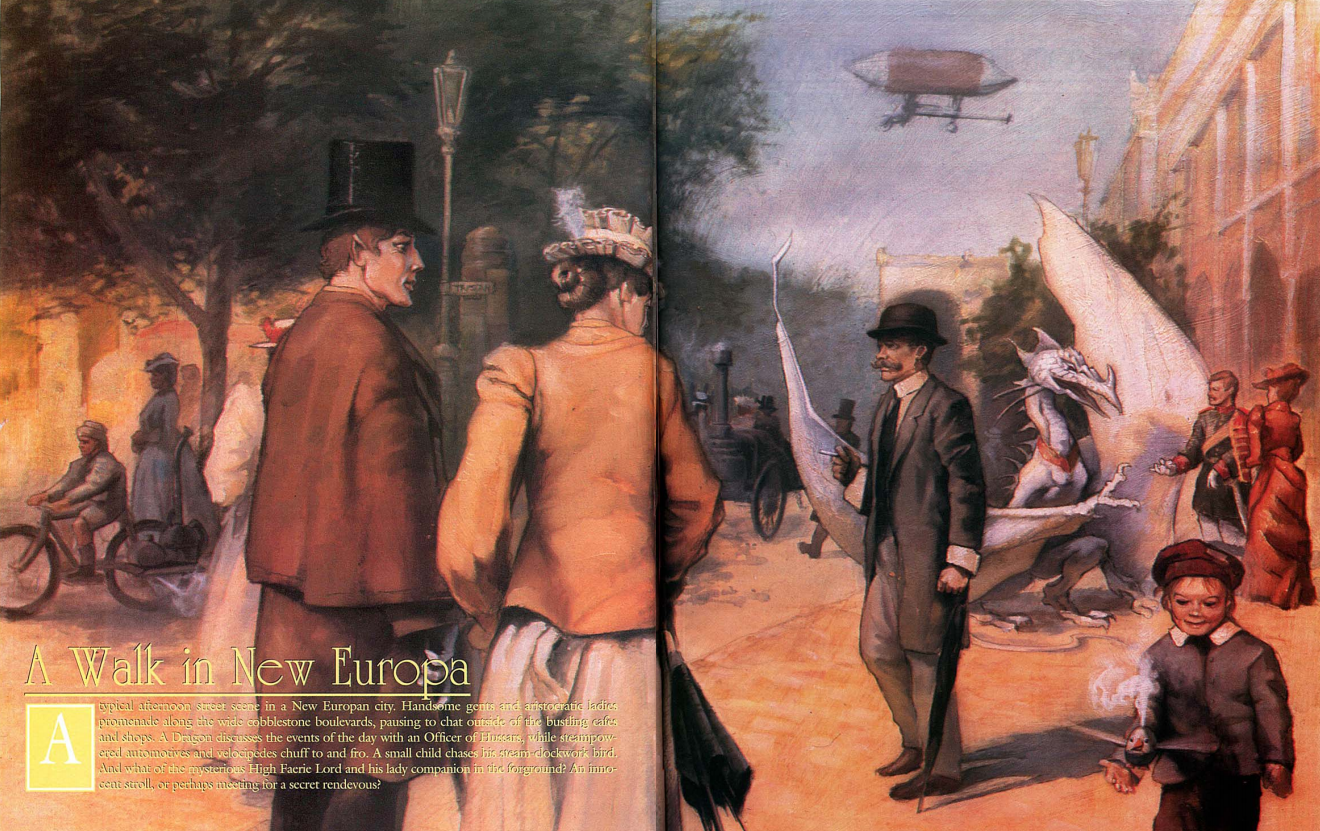
I’m going to start posting a lot of smaller updates more often instead of the huge ones once an eon now, so first is a short bit that quickly describes the general setting of New Europa, broken down into topic:
Steam Power is everywhere! Ships, factories, automotives, war machines, trams, elevators, and anything else they can fit a boiler and stack to. Electricity is seen as dangerous, hard to use, and rather impractical, relegating it to the domain of eccentrics and scientists. Anything to small to be steam-powered use clockworks, which are much more advanced than the equivalent in our own 1800s.
Medicine still sucks. They’ve got things like carbolic sprayers and alcohol for antiseptic purposes, and morphine and opium for anaesthetic, but that’s pretty much it. Doctors still operate in their street clothes, antibiotics haven’t been discovered yet, and the rule of thumb is “When in doubt, get the bonesaw”. A bigger problem is that there’s no shortage of snake-oil salesmen looking to revolutionize the medical field. Potions and elixirs of every sort, rubs and ointments and miracle pills and powders, and those will just poison you! The worst is the new fad of “Galvanic Therapy”, which is a fancy way of saying they shock the hell out of you for health.
Warfare is both less and more advanced that the real world. While there are primitive submarines, the Prussian Landfortress steamtanks, and turbine powered ironclad destroyers for vehicles, guns are more primitive than in our world. Most guns are breechloaders, and the sword is still an important tool of war. This is likely a concession to make Fencing actually useful in a real fight compared to guns.
Police , at least in the modern sense, don’t exist. London has the famous Scotland Yard, but most towns rely on a local constable or militia. Think a combination of Wild West sheriff and Medieval Town Guard. Generally chosen by the local lord, mayor, or other figure of authority. Forensics and criminology are unheard of, there’s a reason Sherlock Holmes becomes world famous, and most detectives and constables rely on a network of informants, a lot of footwork, and the occasional bribery and beating to get evidence. There are “real” criminal investigation organizations, such as the french Surete, or United States Secret Service, but these organizations are more focused on international crime or espionage. And don’t even think about the Secret Police of countries like Russia and Prussia, seriously, they can tell when you do and they don’t like it.
Punishment isn’t any more advanced, Your guild and sentence are both generally up to the local judge, with a Trial by Jury being generally unknown outside of Britain, and the French at least have a tribunal to decide. The general rule is that assault is a minor offence (Unless you assault a noble or rich man), with things like theft getting the harshest penalties. In actuality though, it just depends on what the Judge feels like today. Traditional punishments include: Hanging, Guillotining, exile, getting sent to Australia or Devil’s Isle, or brutal labor-imprisonment ala Les Miserables.
Communications rely on horse-based postal services, telegraphs, or magic. The phone isn’t invented yet, though Bell is working on it. Postal services have pick ups once a day, or up to ten times in a city, and shipped via carriage or fast horse to their destinations. Sorcerers have an advantage, as they can instantly transport a letter to the target or use magic to send the message, but good ones are rare and their time is not cheap. Telegraphs are the main method of sending information nowadays, and connect all of New Europa together, and recently even stretch across the Atlantean (not Atlantic) Ocean to America.
Media is all about the paper. Because of the cheapness of printing and an explosion of literacy thanks to higher education across the world newspapers, magazines, and books are the preferred method of information and entertainment dissemination. Popular newspapers are the Daily Telegraph and Times (London), Le Moniteur and Le Figaro (Paris), Suddeutsche Press (Bayern), and the Neue Freie Presse (Vienna). Popular magazines are Vanity Fair (Gossip and Current Events), Popular Invention (Science and Technology), and The Strand Mystery Magazine (Mystery Stories).
Travel is all about the horse, at least for most people. Hansom, carriage, or horseback is the standard method of travel for short distances or within cities and towns. For longer trips, trains are the norm, with a variety of ships for water travel, such as small steamships for rivers and seas, and steam liners and vane-clippers for crossing Oceans. Aircraft are almost unheard of, though Count Zeppelin is hard at work on his airships.
Magick is less common than you’d think. First of all, real magickal talent is fairly rare, and most people go there whole lives without seeing a mage. Secondly, mages are traditionally members of various secret Lodges and Orders and therefore are rather private individuals who keep quiet about their affairs. Think high-level scientists: There aren’t many of them, you’ll never see one if you don’t hang about the right sort of place, and they only occasionally make the news.
Next Time: Selected Personages of the Steam Age
Selected Personages of the Steam Age
Original SA post
Selected Personages of the Steam Age
This is in essence a list of notable and important people who you may add to your game as NPCs, or even use as player characters if you want to. This section also establishes an important aspect of the Falkenstein setting: Fantasy is Reality. Every fictional, imaginary, or otherwise pretend person ever written of in the Victorian era, heck even set in the Victorian era, exist. THis also means all stories have likewise happened or WILL happen. Note, that just because they talk about novels in the past tense, that’s no reason the PCs couldn’t get involved! You don’t have to set the game in 1870 after all. For example: Invaders from space piloting giant tripods really did invade Britain from a landing site in Essex. The rest you’ll see as we go!
-
Charles Babbage:
A Cambridge mathematician who invented the Babbage Calculation Engine, a primitive computer. While in the real world this was seen as an oddity, in Falkenstein it was quickly popularized and now plays a major role in New Europa. He currently works for the Lycee Analytique in Paris underneath Science Minister Jules Verne.
Alexander Graham Bell: Scottish-American inventor. Not famous as yet, but he’s working on the telephone.
Sarah Bernhardt: Half-Faerie French actress and rising star of the Paris stage. In the real world she was one of the most famous actors of the turn of the century.
Elizabeth and Robert Browning: Poet couple who wrote Sonnets from the Portuguese. Elizabeth is unnaturally young due to an undiscovered and unconscious talent for Magick. In the real world they were two of the Victorian eras most famous poets.
Sir Francis Richard Burton: I’m just going to quote Wikipedia here.
Wikipedia.com posted:
Captain Sir Richard Francis Burton KCMG FRGS (19 March 1821 – 20 October 1890) was an English geographer, explorer, translator, writer, soldier, orientalist, cartographer, ethnologist, spy, linguist, poet, Egyptologist, fencer and diplomat. He was known for his travels and explorations within Asia, Africa and the Americas, as well as his extraordinary knowledge of languages and cultures. According to one count, he spoke 29 European, Asian and African languages.
Burton's best-known achievements include traveling in disguise toMecca, an unexpurgated translation of One Thousand and One Nights(commonly called The Arabian Nights in English after early translations of Antoine Galland's French version), bringing the Kama Sutra to publication in English, and journeying with John Hanning Speke as the first Europeans to visit the Great Lakes of Africa in search of the source of the Nile. Burton's works and letters extensively criticized colonial policies of the British Empire, to the detriment of his career. He was a prolific and erudite author and wrote numerous books and scholarly articles about subjects including human behaviour, travel, falconry, fencing, sexual practices and ethnography. A characteristic feature of his books is the copious footnotes and appendices containing remarkable observations and information.
He was a captain in the army of the East India Company, serving in India (and later, briefly, in the Crimean War). Following this, he was engaged by the Royal Geographical Society to explore the east coast of Africa and led an expedition guided by the locals and was the first European to see Lake Tanganyika. In later life, he served as British consul inFernando Po, Santos, Damascus and, finally, Trieste. He was a Fellow of the Royal Geographical Society and was awarded a knighthood(KCMG) in 1886.
Yeah. Oh, and he knows Magick.
Lewis Carroll: Oxford mathematician and author of childrens novel Alice in Wonderland. In our world it was just that: A childrens book. In New Europa? It’s a fictionalized textbook of alternate realities. Turns out he (And Alice Liddell) found a way to enter the Faerie Veil, the world between worlds, and his writings are a fictionalized account of their journeys.
Captain John Carter: Confederate veteran of the American Civil War, and Warlord of Mars. Captain Carter can psychically transport himself and others to an alien world called Barsoom, where he is a warlike King. From Edgar Rice Burroughs A Princess of Mars and sequels.
Charles Darwin: Biologist and Naturalist, formalized and popularized the Theory of Evolution. Only real difference is that he’s also interested in the evolutionary ancestry of Dragons, Faeries, and Dwarfs.
Charles Dickens: Elderly novelist, world famous, etc. etc. you know who Charles Dickens is.
Benjamin Disraeli: Novelist, statesman, former Prime Minister. One of Queen Victoria’s top advisors and considered to be the British equivalent of Bismarck.
Count Vlad Dracula: Half Unseelie Ferie offspring between a Glastig and a descendant of Vlad the Impaler. The Count currently “travels” around the Continent, constantly persued by the dogged Dr. Abraham van Helsing. From Bram Stoker’s Dracula.
Thomas Edison: Prodigious American inventor who has created the Light Bulb, mimeograph, was paper, stock ticker, and the motion picture camera. Most famous inventor of the age, and currently runs a consulting firm in New York.
Prince Edward: Crown Prince of England and supreme socialite. The Marlborough House Set is the who’s who of British Society and he decides if you are a Who or a Who Cares.
Phileas Fogg: World traveller and writer, famous for circling the world in 80 days (Don’t believe what that Verne man writes though, he dramatized it quite a bit). Surrounded by rumors of possibly being a Faerie, an Alien, a Robot, or other such outlandish tales. From Jules Verne’s Around the World in 80 Days.
Dr. Victor Frankenstein: A Swiss medical doctor and amateur magician who tried to combine Magick and Mad Science to create artificial life. While his first attempt ended in tragedy, he survived to try again! From Mary Shelley’s Frankenstein.
Ulysses S. Grant: General of the Union Army in the American Civil War and current US President.
Sherlock Holmes: 20 something Oxford graduate who has recently opened an office in London as a “Consulting Detective”. Has just started his career, and is yet to meet Dr. Watson. From Arthur Conan Doyle’s Sherlock Holmes stories.
Aldous Huxley: British biologist and supporter of Darwin. Well known lecturer and scientific advocate, heavily dedicated to Progress at any cost.
Dr. Jack Griffin: Chemist who developed an invisibility potion, the use of which seems to have driven him mad. He is now an infamous criminal, famed for his unstoppable one-man crime waves.
Lord Kelvin (William Thomson): Mathemetician and Physicist at Glasgow University. Formost authority of physics, electricity, and specialist in Engine Magic (More on that later) and member of the Second Compact (Likewise, but it means he’s a Good Guy).
Abraham Lincoln: Former president of the United States. Won the Civil War, ended American slavery, and survived an attempted assassination thanks to Magickal aid to go on and finish Reconstruction.
Lady Ada Lovelace: Daughter of Lord Byron and assisstant to Charles Babbage. The worlds first computer programmer, and member of the Temple of Ra, a pro-superscience magickal organization.
Ludwig the First: Grandfather of Ludwig II, famous architect, known to be loony. Married to exotic dancer Lola Montez, and now travels the world acting as a great patron of the arts.
Karl Marx: Political scientist and inventor of Communism. Head of the Anarchist Brotherhood, a secret organization of political activists dedicated to bringing about a Communist Utopia.
Professor Moriarty: Criminal Mastermind and head of the World Crime League! Future arch-nemesis of Sherlock Holmes, though now his greatest foe is the dogged Captain Nemo and his sometime ally Phileas Fogg. From Arthur Conan Doyle’s Sherlock Holmes stories.
Emperor Norton I: Formerly a colorful San Francisco local and street-kook, he has been elected President/Emperor of the newly formed Bear Flag Republic/Empire.
Dr. Richard Owen: Pioneer of Paleontology and discoverer of Dinosaurs.
Rudolf Rassendyl: English Gentleman and look-alike to the King of the small German nation of Ruritania. Helped foil a Bismarckian plot to conquer Ruritania by imprisoning the king and replacing him with his pro-Prussian half-brother. From Alexander Hope’s The Prisoner of Zenda.
Robur the Conqueror: Airship designer and would-be world conqueror. Pilot of the Albatross, a 200 foot long proto-Helicopter. Aerial Pirate and member of the World Crime League. From Jules Verne’s Master of the Air.
The Time Traveller: A man of unknown identity who has invented a functioning time machine! Suspected to be a sorcerer as well as a master inventor, he appears mysteriously to shape history to change a future only he knows of. So, basically Doctor Who. From H.G. Wells The Time Machine.
Dr. Abraham van Helsing: Dutch vampire hunter and occultist. Archfoe of Count Dracula, and dedicated to destroying all vampires and other evil creatures in the world. From Bram Stokers Dracula.
Dr. Jules Verne: Inventor and Novelist. Minister of Science for Napoleon III, he comes up with the concepts and his teams of engineers and scientists make them reality.
Queen Victoria: Queen of England and the most powerful woman in the world. Stubborn, autocratic and single minded, she’s helped by a massive cabinet of Ministers and the fact that she’s a relation to almost every crowned head in New Europa. Unfortunately she’s heavily influenced by the Steam Lords (Later!).
Count Ferdinand von Zeppelin: Inventor of the lighter-than-air craft, and former Union officer during the Civil War. Head of Bismarcks fledgeling Luftwaffen Airship Corps.
Next time: Secret Agents and Secret Societies